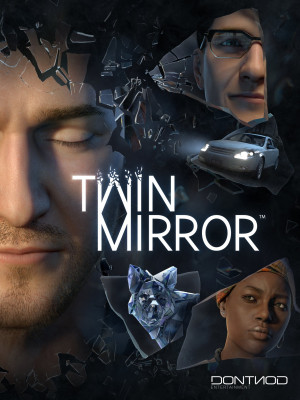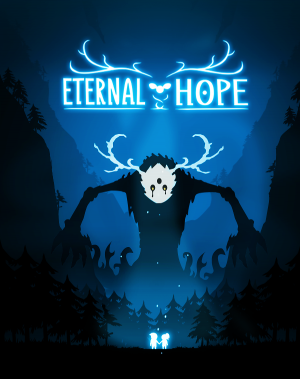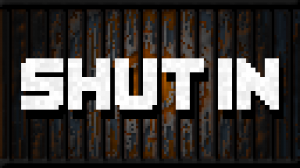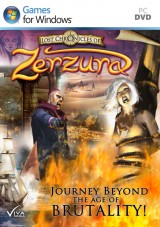Review for Twin Mirror

Duality is a central theme in Twin Mirror: the idea that the way a person looks, feels and behaves under one set of circumstances might be wildly at odds with who they are in another. Take Sam Higgs, the game’s protagonist. Outwardly cold and analytical, Sam is nonetheless in constant conversation with his Double, a sort of mentally constructed doppelganger who’s meant to embody all the warm, wise and compassionate feelings that don’t come naturally to him. They’re two faces of the same man, and to consider one without the other is to have an incomplete understanding of who Sam is. It’s appropriate, then, that Twin Mirror itself exists in a state of contradiction. On the one hand, it’s a production of DONTNOD Entertainment, a studio with a deserved reputation for releasing quality titles featuring deep, character-centered stories, compelling mysteries, and creative choice-based mechanics, while on the other ... well, it isn’t very good.
The story starts out promising enough, with several mysteries in the offing and a compelling reason to investigate. Two years ago Sam left his hometown of Basswood, West Virginia after a series of personal and professional collapses, cutting off all contact with friends and loved ones and rebuffing their attempts to check on him. He’s only returning now to attend the funeral of his best friend, Nick, who has died unexpectedly; after the ceremony he plans to depart again without looking back. He winds up getting into town late and just barely makes it to the reception, where Nick’s twelve-year-old daughter Joan—Sam’s goddaughter—begs Sam to investigate her father’s death. She insists that the facts don’t add up, and that as a former investigative journalist Sam is the only person who can get to the bottom of it. Before he can decide whether to leave or get involved, the choice is unexpectedly—and violently—made for him, and suddenly it’s a race against time to uncover the sinister forces at work in Basswood before they bury Sam and everything he holds dear.
You move Sam with the WASD keys and control the camera with the mouse. Approaching a hotspot causes a hovering marker to appear above it, but in what quickly proves to be a frustrating, unintuitive process, you’ll have to first move Sam so that the hotspot is in his line of sight, then click and hold the mouse button to reveal a list of your available actions, keeping it pressed as you select the corresponding key (usually also WASD). These controls are maddeningly sluggish; it often took multiple mouse clicks to make the hotspot respond, and several further tries to persuade the context-sensitive system to sense the context in which I needed the WASD keys. (Using a gamepad would probably solve a lot of these problems; they're theoretically supported, but the Epic Games Store—to which Twin Mirror is currently exclusive—is notoriously finicky about which models are supported.) Thankfully, given the finicky nature of the controls, the game saves automatically.
The bulk of the puzzles revolve around two unique abilities that have helped Sam to become a skilled investigator. The first of these is his aforementioned technique for visualizing his Double, which grants him a built-in devil’s advocate figure with whom he can debate the merits of his current course of action. The second is the “Mind Palace,” a mental landscape Sam visits when going back over his thoughts, memories and observations; doing so essentially lets him relive earlier experiences and examine them for new insights. This is also where he sifts through the information he’s gathered in order to reconstruct events he didn’t actually witness. The Palace's geography changes to reflect Sam’s mental status, appearing as a clear and tranquil sky realm during calm moments and a dark and fragmented labyrinth when he’s stressed, upset, or panicked. (Both the Double and the Mind Palace are established explicitly as psychological constructs that Sam uses to visualize what he’s thinking and feeling; in a departure for DONTNOD, Twin Mirror lacks even a hint of the paranormal.)
Mind Palace puzzles mostly involve combing a real-world area for clues until an on-screen indicator proclaims you’ve found enough to determine what happened there. You'll manage this by selecting possibilities from a menu and stringing them together; shimmering representations of the participants then materialize to play out your scenario so you can examine it for consistency. You'll do this to figure out next steps, to fill in gaps in a story, or to determine whether what you’ve been told matches the evidence. In one scene, for instance, you’ll analyze the aftermath of a bar fight to figure out how it unfolded—who was involved, who witnessed it, and where the combatants ended up—while in another you’ll pick through the scene of a car wreck for clues about what caused it.
There are seeds of a creative investigation mechanic here, and a few solutions do have a real gleam of originality; as with the controls, though, poor implementation hamstrings most of the other puzzles. The evidence-gathering process is a slog, in many places feeling like little more than a high-res pixel hunt. You rarely get a clear idea of what you’re looking for except “clues,” meaning the parameters of what you should focus on go mostly undefined. Worse, the small white hotspot markers blend easily into the background in outdoor scenes, so that you can walk right past them a dozen times without realizing they’re there. This leads to long stretches of aimless, back-and-forth wandering where you know neither what you're looking for nor where to find it. Tracking down the final clue in a given scene never felt like an accomplishment or a triumph of my detective skills; if anything it felt like flailing in the dark for a light switch and accidentally finding my car keys, which I hadn’t noticed were missing.
Putting the pieces together should have been the most engaging part of the process, but the game does most of the heavy lifting for you. Rather than having to physically reconstruct the scene you’re investigating or draw connections between various bits of data, the game presents you with a list of three or four possibilities and asks you to select one. The bar fight scene, for instance, gives you three possible locations where the participants might have fallen to the ground, but you don’t have anything to do with assembling that list; once you’ve gathered all the evidence the game just presents it to you, with its own predetermined limitations. It’s a big place—why does it have to have been one of those three? The game doesn’t say. It would have been more rewarding to let players make those connections themselves and then actively test their hypotheses, rather than simply having a one in three chance of guessing and an immediate chance to try again if you guess wrong.
Conversing with Sam’s Double is more satisfying, to the point that I often wished I could summon him myself rather than waiting for the game to bring him out. Clean-cut, warm, and thoughtful, the Double is everything Sam doesn’t know how to be on his own, and it’s pleasant to witness their brainstorming sessions. The interplay between them is lively, like two siblings who love each other despite their bickering, and the Double’s occasional reminders that he is, in fact, imaginary don’t detract from that feeling of affection and camaraderie. He’s more level-headed than Sam is, and he often gives helpful guidance, but his overly cautious attitude doesn’t always provide the best approach when action is required. At times you’re prompted to choose one side over the other when the two debate strategy; at other points you can ask the Double for advice about what to say to other characters. (From the player’s perspective, conversations with the Double seem to unfold in real time, but the game takes pains to demonstrate that they’re really happening in Sam’s head at the speed of thought; most of the time he can interact with others simultaneously without missing a beat.)
Sam’s relationship with his Double is portrayed with care and exposition-free grace; neither ever feels the need to state outright to the other their history together or the parameters of their interactions, and we perceive their feelings for one another by observing, not by being told. Unfortunately, the thoughtful characterization on display in this one instance serves to highlight its relative absence in the rest of the game. We’ve all heard the old adage that a writer should “show, not tell” whenever possible, and while it’s not as universally applicable as many insist, it’s an effective reminder that people usually connect better with a story that lets them experience things for themselves than one that simply explains itself. Most of the time, and much to its detriment, Twin Mirror is the latter kind. Characters state their feelings and motivations out loud, or explain past events to each other that both should logically remember.
Compounding the issue, what we hear about people and their relationships often conflicts with what we actually observe, so that I felt I was being asked to accept what I’d been told against the evidence of my senses. Sorrow over Nick’s death, for instance, is positioned as a central motivating factor for Sam and several others, but by the time the game ended I didn’t feel I knew any more about him than I had when it started. He and Sam were supposedly inseparable, but the flashbacks and reminiscences we see don’t demonstrate the sense of long history and mutual understanding that comes of spending decades together (and which we do see between Sam and the Double). Instead they serve mostly as sources of exposition about the past or to provide context for the present; the game needs us to know they were friends so the story will function, but it doesn’t seem to care much whether we believe in it beyond that.
The same is true of the other people in Sam’s life, from important supporting characters like his goddaughter Joan and his ex-girlfriend Anna to the various residents of Basswood you’ll interact with. Most of them wind up feeling like thinly sketched caricatures, with perhaps one notable personality trait apiece: the newspaper editor who speaks almost exclusively in literary references, the motor-mouthed town gossip, Nick’s overworked ex-wife Kathy. We’re supposed to be able to feel the history Sam shares with this community, to believe that he cares for these people and that they mean something to him in spite of his past attempts to self-isolate, but despite all the dialogue spelling out their roles, very little effort goes into making them feel like more than plot devices.
The dialogue itself does little to endear you to the characters. It's littered with awkward and overwritten clunkers such as “Of the qualities in a good man, that one deserves to be at the top,” and “Anna always has trouble thinking when there's weird noises going on.” Too often a moment begins to build tension or genuine emotion only to have something ridiculous pop out of a character's mouth that dissipates it. (I can't let this review pass without calling out the tender flashback in which Sam addresses his reporter girlfriend as "my princess of the typefaces" while fixing her computer. I'd have dumped him too.) There are also translation issues, with kitchen cabinets referred to as “closets” and a restaurant booth that bears the inexplicable hotspot tag “booth aplustre.” On top of all that, the 3D graphics appear years out of date, with unconvincing character models and lip sync that fails to convincingly match the dialogue.
But all of this is secondary to the central issue, which is that Sam never develops into a character of his own, and certainly not one who can carry this story by himself. I said before that what we're told frequently fails to line up with what we can observe, and nowhere is this more apparent than in Sam’s characterization. There’s a crush of dialogue—from others, from the Double, from Sam himself—centered on the idea of Sam as an awkward recluse who barely functions in society, who doesn’t understand how to talk to others or maintain healthy relationships. The heavy implication is that he suffers from a personality disorder, albeit a nonspecific and vaguely defined one, and that we should perceive both the Double and his Mind Palace as being somewhere between hallucinations and dissociative episodes.
The Sam we see doesn’t match the one we hear about, however. In his real-life conversations, in his internal monologues and in his back-and-forth with the Double, he comes across as an emotionally withdrawn but otherwise neurotypical adult, and he seems to have no trouble socializing when he feels like it. In the real world, of course, a learned understanding of superficial social conventions can often mask an underlying disconnect, but in a game that actively grants us access to a character’s psyche, we should be able to perceive that gap from within. Twin Mirror doesn’t let us do that, nor does it give us real examples of other oft-mentioned aspects of his personality, like the supposedly legendary stubbornness that earned him the nickname “Muley.” Over and over, we hear about these things, but despite being literally inside the man’s head we don’t actually get a sense of them.
That’s a shame, because the Sam we actually get to see, to put it bluntly, is bland. For all we’re expected to believe about him—that he’s passionate to a fault, a dogged investigator, a loyal friend, and a frequently self-centered jackass—he never actually demonstrates what feels like a real personality. He wants to solve the mystery of what’s happening in Basswood, and to protect the people he loves, but these largely universal desires don’t provide much insight into who he is; he’s trying to put the past behind him and mend the bridges he’s burned, but we don’t ever feel his motivation for doing so. Even in his conversations with the Double, it’s the latter who leaves the biggest impression, with Sam mostly responding and reacting to him. Like Nick, there’s very little I can think of to actually say about Sam—except Sam was actually alive and on-screen the whole time. He has a troubled past, a sharp mind, and an apparent drinking problem; other than that he’s a cipher. The game never justifies this person being at the center of this story; it feels like he’s only there because somebody had to be, and somebody is all the developers provided.
DONTNOD’s success with Life is Strange owed something to its episodic release model. Telling a story across a series of two- to three-hour episodes allows for natural act breaks and more structured pacing, which often grants the setting, plot and characters more space to develop organically alongside the player’s interest and curiosity. Twin Mirror was originally planned for release in three installments, but that model was abandoned midway through production; the roughly seven-hour playtime that resulted doesn’t allow for the same kind of nuance as DONTNOD’s other titles. The story here feels rushed and slight, sending players from location to location at such breakneck speed that there's no opportunity to become invested in the setting or characters. Its hurry to get from point A to point B results in some baffling or nonsensical decisions by otherwise rational people, all in the name of moving the plot along. Most egregious of these is the method Sam identifies to overcome one mid-game obstacle, which is so excessive and morally indefensible that it’s jaw-dropping when he has no trouble enlisting the help of a highly ethical character to achieve it. Once it’s done it’s on to the next story beat, with hardly a mention of the repercussions for any of the participants; Sam got where he needed to go, and that’s all that matters.
Its relative brevity means there are only three or four opportunities to really make full use of the Mind Palace mechanic, and DONTNOD’s now-trademark choice-based narrative style feels abbreviated and underused. There are five endings available, but for the most part they all derive from huge, signposted “CHOOSE X OR Y” moments, rather than the many small decisions whose rippling consequences helped make Life is Strange so special. The hectic pace also leaves the game’s earnest attempt to tackle topics rarely examined in gaming—including the opioid crisis, the plight of small communities in thrall to big industries, and the often silent partnership between business, the authorities, and organized crime—feeling perfunctory instead of affecting. I’ve never played a game that gave me a good look at life in West Virginia’s coal country without caricature or condescension, and to its credit Twin Mirror does try. Like so much else on offer here, though, I don’t feel as if I know any more now than I did beforehand.
None of this is to say that Twin Mirror lacks its good points. The scenery is well-designed, and the game’s portrayal of a rural, single-industry American town feels true to life. (Take it from me, a man whose hometown not only passed “No Horses Allowed” laws on the bike trails but had to enforce them.) The soundtrack includes some catchy, mood-setting country tunes, and the voice acting is generally effective, with Graham Hamilton doing an especially impressive job bringing Sam and the Double to life as distinct characters. The Mind Palace, in its more sinister guise, is rich with surreal menace and bizarre scenery that creatively embodies the trappings of Sam’s subconscious, and the puzzles in these sequences, which involve navigating Sam past his more negative emotions and unraveling the dream-logic around them, are for the most part nicely conceived and executed. All of these aspects deserve praise; they just aren’t enough to save the game from itself.
It would be easier to accept Twin Mirror’s shortcomings—if not to overlook them—if the developers hadn’t shown themselves to be capable of much better. A flat, forgettable game with dodgy writing, bad controls and unsatisfying puzzles would be a disappointment no matter who made it, but it's a particularly harsh letdown from a studio with DONTNOD’s track record. Still, Twin Mirror represents a departure for the studio in many ways: it lacks paranormal elements, its protagonist and most of its major characters are adults, and it's a standalone release instead of an episodic one. It’s good that the developers are still trying to take risks after reaching a position of relative comfort, and hopefully the lessons they learn here will inform and enrich whatever project they take on next. They appear uninterested in repeating themselves ad nauseam, and that’s a good thing. If nothing else, it means we shouldn’t expect another disappointment like Twin Mirror.































